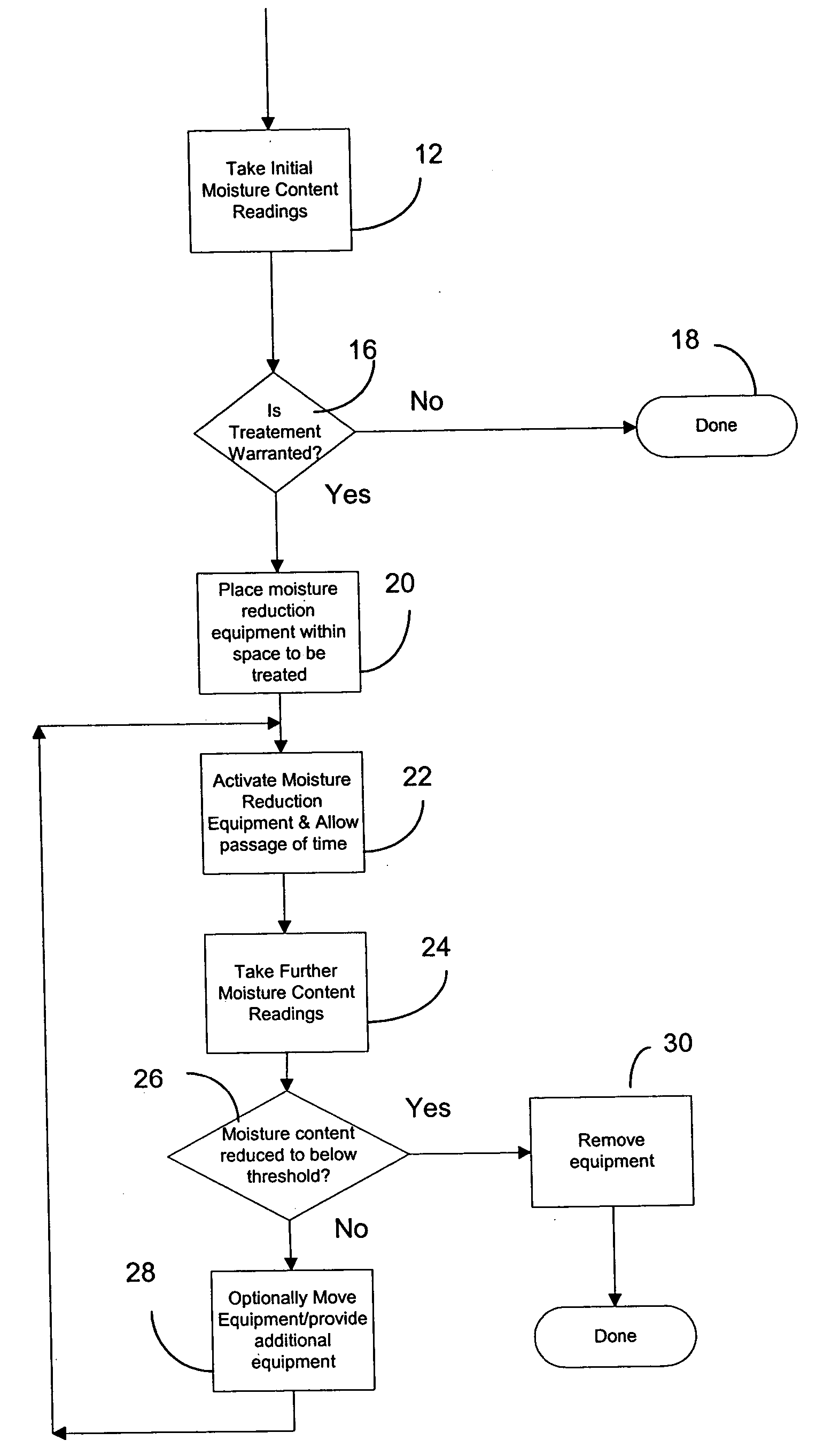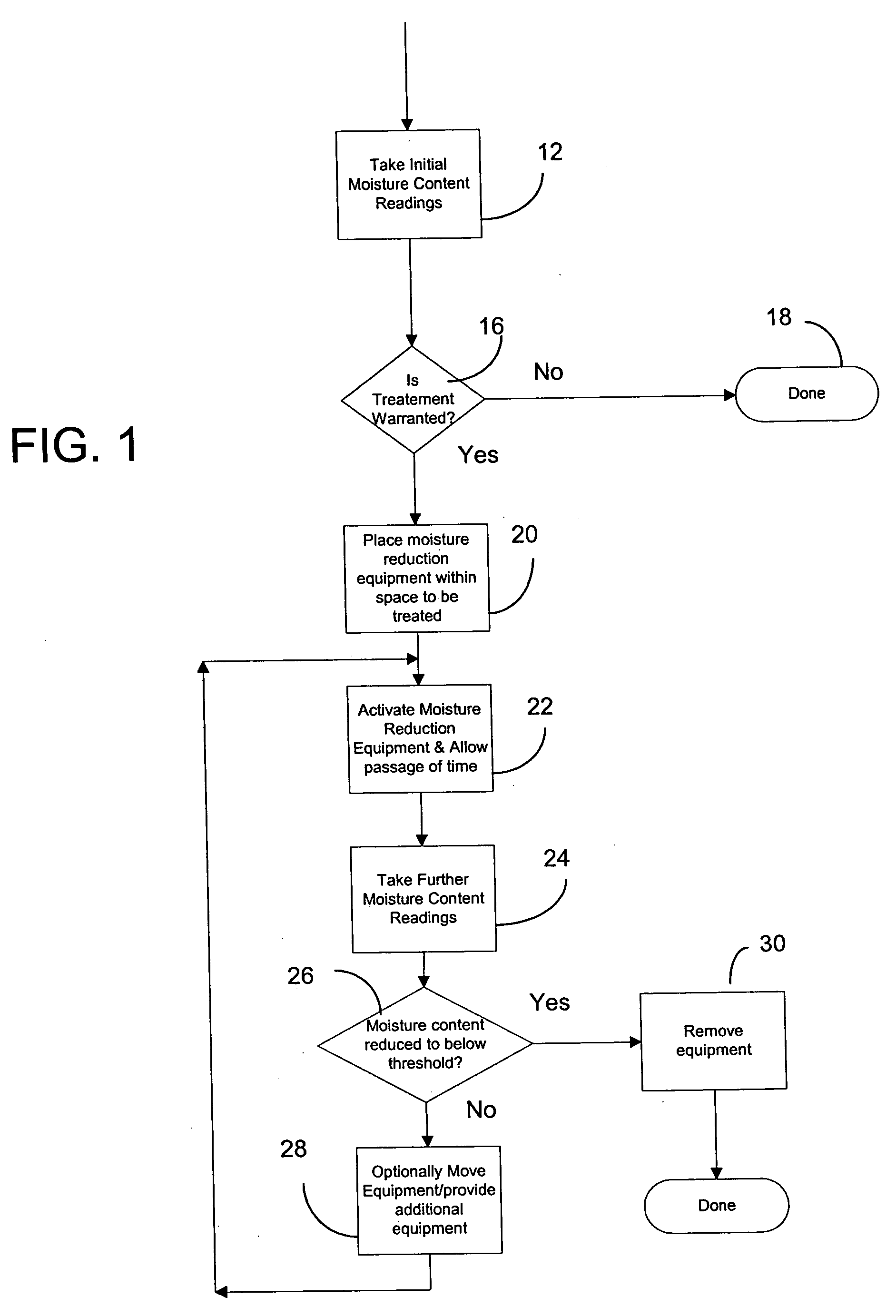Moisture reduction and mold and moisture damage preventative system and method in construction
a technology of preventative system and moisture damage prevention, which is applied in the field of building and construction, can solve the problems of substantial remediation efforts, associated costs or litigation, and the increase of mold and mildew problems in buildings, and achieve the effect of reducing moisture in construction projects and removing moistur
- Summary
- Abstract
- Description
- Claims
- Application Information
AI Technical Summary
Benefits of technology
Problems solved by technology
Method used
Image
Examples
example 1
[0028] New construction, 1500 square feet.
[0029] Day 1, temperature 71.5° F., 36.7% relative humidity. 2 measurements were taken low along wall studs, giving 16 and 18% moisture content. 4 measurements were taken high along wall studs, giving 16, 24, 21 and 21%.
[0030] Moisture removal equipment was installed and allowed to run for the rest of day 1. On day 2, temperature was 64.7° F., 46.9% relative humidity. 2 measurements were taken low along wall studs, giving 16 and 18% moisture content. 4 measurements were taken high along wall studs, giving 16, 18, 18 and 18% moisture content. The moisture removal operation was judged completed.
example 2
[0031] New construction, 2200 square feet.
[0032] Day 1, temperature 69.4° F., 49.1% relative humidity. 7 measurements were taken low along wall studs, giving 25, 20, 25, 25, 15, 25 and 22% moisture content. 7 measurements were taken high along wall studs, giving 21, 19, 25, 25, 25, 25 and 25%.
[0033] Moisture removal equipment was installed and allowed to run. On day 2, temperature was 65.1° F., 55.3% relative humidity. 7 measurements were taken low along wall studs, giving 20, 17, 25, 25, 20, 21 and 20% moisture content. 7 measurements were taken high along wall studs, giving 22, 18, 23, 23, 15, 21 and 20% moisture content. The moisture removal operation was continued, and then further measurements were taken on day 3. 6 lower level measurements of 20, 18, 18, 18, 15 and 21% moisture content were taken, and 7 upper level measurements of 18, 17, 20, 23, 18, 18 and 20% were recorded. Moisture removal was continued and on day 4, 7 measurements were taken at both lower and upper level...
example 3
[0034] New construction, 2300 square feet.
[0035] Day 1, temperature 63.2° F., 38.0% relative humidity. 7 measurements were taken low along wall studs, giving 15, 20, 15, 15, 30, 30, and 16% moisture content. 7 measurements were taken high along wall studs, giving 30, 30, 30, 18, 25, 24 and 20%.
[0036] Moisture removal equipment was installed and allowed to run until day 2, when further measurements are made, temperature was 80.2° F., 29.5% relative humidity. Measurements low along wall studs were 15, 15, 15, 15, 20, 15 and 16% moisture content. High location measurements were 25, 20, 25, 18, 23, 20 and 20% moisture content. The moisture removal operation was continued until day 3, when measurements as follows were judged to have sufficiently accomplished the desired moisture removal: low, 15, 15, 15, 15, 18, 15, 16%; and high 18, 17, 18, 18, 16, 15, 18%.
PUM
 Login to View More
Login to View More Abstract
Description
Claims
Application Information
 Login to View More
Login to View More - R&D
- Intellectual Property
- Life Sciences
- Materials
- Tech Scout
- Unparalleled Data Quality
- Higher Quality Content
- 60% Fewer Hallucinations
Browse by: Latest US Patents, China's latest patents, Technical Efficacy Thesaurus, Application Domain, Technology Topic, Popular Technical Reports.
© 2025 PatSnap. All rights reserved.Legal|Privacy policy|Modern Slavery Act Transparency Statement|Sitemap|About US| Contact US: help@patsnap.com


